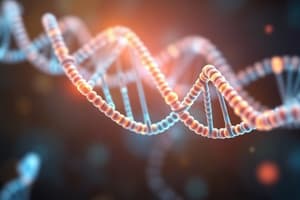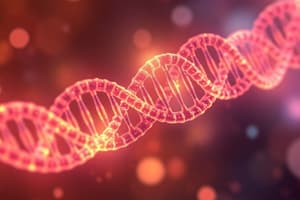Podcast
Questions and Answers
What was the primary significance of Frederick Sanger's research on insulin?
What was the primary significance of Frederick Sanger's research on insulin?
- It resulted in the sequencing of the first human mitochondrial genome.
- It enabled the isolation and cloning of DNA fragments for genetic modification.
- It paved the way for understanding the double-helix structure of DNA.
- It led to the development of synthetic insulin for diabetes treatment. (correct)
Following his 1958 Nobel Prize, what was Sanger's primary research focus?
Following his 1958 Nobel Prize, what was Sanger's primary research focus?
- Isolating and cloning DNA fragments.
- Developing a method for sequencing proteins.
- Creating modified genes to treat genetic disorders.
- Understanding the structure and function of nucleic acids. (correct)
Which scientific milestone did Sanger achieve in 1967?
Which scientific milestone did Sanger achieve in 1967?
- Determining the complete sequence of RNA from *E. coli* bacteria. (correct)
- Developing the dideoxy chain termination method.
- Sequencing the first human mitochondrial genome.
- Sequencing the entire human genome.
What was the key breakthrough in Sanger's DNA sequencing research in 1977?
What was the key breakthrough in Sanger's DNA sequencing research in 1977?
What significant achievement did Sanger accomplish in 1981?
What significant achievement did Sanger accomplish in 1981?
What crucial biological function does DNA, which Sanger studied extensively, govern?
What crucial biological function does DNA, which Sanger studied extensively, govern?
What did Sanger mean when he stated, "I had 20 years when I could just do what I wanted"?
What did Sanger mean when he stated, "I had 20 years when I could just do what I wanted"?
How did Sanger's sequencing method contribute to the broader field of genetics?
How did Sanger's sequencing method contribute to the broader field of genetics?
What aspect of DNA did Sanger believe to be more complex?
What aspect of DNA did Sanger believe to be more complex?
What was the critical purpose of using radioactive isotopes in Sanger's sequencing method?
What was the critical purpose of using radioactive isotopes in Sanger's sequencing method?
Flashcards
Frederick Sanger
Frederick Sanger
A British biochemist who won two Nobel Prizes in Chemistry.
First Nobel Prize in Chemistry
First Nobel Prize in Chemistry
Awarded to Sanger in 1958 for his insulin research.
Sequencing of Nucleic Acids
Sequencing of Nucleic Acids
Sanger's focus on understanding RNA and DNA structures.
Double-helix Structure
Double-helix Structure
Signup and view all the flashcards
Sequencing Method
Sequencing Method
Signup and view all the flashcards
Dideoxy Chain Termination
Dideoxy Chain Termination
Signup and view all the flashcards
Human Mitochondrial Genome
Human Mitochondrial Genome
Signup and view all the flashcards
Applications of Sanger's Method
Applications of Sanger's Method
Signup and view all the flashcards
1958 Nobel Prize Achievement
1958 Nobel Prize Achievement
Signup and view all the flashcards
Sequencing Breakthrough Years
Sequencing Breakthrough Years
Signup and view all the flashcards
Study Notes
Nobel Prizes in Chemistry
- Frederick Sanger won two Nobel Prizes in Chemistry
- Sanger's initial research focused on insulin, a protein which influenced research on synthetic insulin for diabetes
- His work progressed to study the body's genetic material - RNA and DNA
Sanger's Sequencing Method
- Sanger developed a method for sequencing DNA based on radioactive isotopes
- This method, employing radioactive isotopes, precisely identified DNA sequences by following fragment overlaps.
- By 1967, Sanger had a complete RNA sequence from E. coli bacteria.
Sequencing DNA
- Sequencing DNA proved more challenging, due to complexity in size and structure (double helix) compared to RNA
- A breakthrough came in 1977 with a technique for isolating DNA fragments via dideoxy chain-termination.
- This method used a molecular inhibitor to stop DNA strands from elongating, allowing fragments to measured from shortest to longest. This allowed the sequence of bases to be determined.
Impact and Applications
- Sanger's technique enabled the sequencing of the first human mitochondrial genome in 1981
- Sanger's sequencing method opened the way for sequencing all 3 billion base pairs in the entire human genome
- This approach facilitated genetic modification and the creation of modified genes to address or resist genetic disorders.
Key Dates
- 1958: Nobel Prize in Chemistry for insulin research
- 1962: Sanger moves to the Laboratory of Molecular Biology
- 1967: Completes RNA sequencing
- 1977: Revolutionary method for isolating DNA fragments
- 1981: First human mitochondrial genome sequenced
Studying That Suits You
Use AI to generate personalized quizzes and flashcards to suit your learning preferences.




